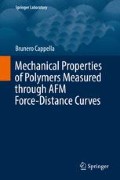Abstract
There are to date very few experiments reporting the measurement of creep compliance or of creep curves with AFM, since most measurements in this field are performed with instrumented nanoindenters and experimental protocols for the acquisition of creep curves are usually not implemented in commercial microscopes. Yet, AFM offers two significant advantages: a better speed performance and a lower thermal drift. For example, the stepping time of an AFM can be smaller than 1 ms, whereas the stepping time of nanoindenters is commonly limited to ca. 1000 ms (Braunsmann et al., Polymer 55:219–225, 2014).
This section presents two hands-on examples. In the first one (Moeller, J Pol Sci B Pol Phys 47:1573–1587, 2009), creep measurements are compared with force–distance curves measurements analysed with Oliver and Pharr method. Limitations of both methods, mainly due to the occurrence of plastic deformations, are surveyed.
In the second hands-on example (Braunsmann et al., Polymer 55:219–225, 2014), the unique feature of AFM, i.e. the possibility of scanning the sample with resolution in the nanometre scale while acquiring creep curves, is exploited.
Access this chapter
Tax calculation will be finalised at checkout
Purchases are for personal use only
References
Moeller G (2009) AFM nanoindentation of viscoelastic materials with large end-radius probes. J Polym Sci B Polym Phys 47:1573–1587
Hutter JL, Bechhoefer J (1993) Calibration of atomic-force microscope tips. Rev Sci Instrum 64:1868–1878
Vandamme M, Franz-Josef Ulm F-J (2006) Viscoelastic solutions for conical indentation. Int J Solids Struct 43:3142–3165
Lu H, Wang B, Ma J, Huang G, Viswanathan H (2003) Measurement of creep compliance of solid polymers by nanoindentation. Mech Time-Depend Mater 7:189–207
Braunsmann C, Proksch R, Revenko I, Schäffer TE (2014) Creep compliance mapping by atomic force microscopy. Polymer 55:219–225
Author information
Authors and Affiliations
Rights and permissions
Copyright information
© 2016 Springer International Publishing Switzerland
About this chapter
Cite this chapter
Cappella, B. (2016). Creep Compliance Measurement. In: Mechanical Properties of Polymers Measured through AFM Force-Distance Curves. Springer Laboratory. Springer, Cham. https://doi.org/10.1007/978-3-319-29459-9_6
Download citation
DOI: https://doi.org/10.1007/978-3-319-29459-9_6
Published:
Publisher Name: Springer, Cham
Print ISBN: 978-3-319-29457-5
Online ISBN: 978-3-319-29459-9
eBook Packages: Chemistry and Materials ScienceChemistry and Material Science (R0)

